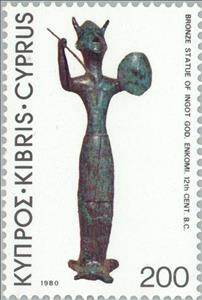Stamp: Bronze statue of Ingot God, Engomi, 12th cent. B.C. (Cyprus 1980)
Bronze statue of Ingot God, Engomi, 12th cent. B.C. (Cyprus 1980)
15 September (Cyprus ) within release Archaelological Treasures goes into circulation Stamp Bronze statue of Ingot God, Engomi, 12th cent. B.C. face value 200 Cypriot mil
| Stamp Bronze statue of Ingot God, Engomi, 12th cent. B.C. in catalogues | |
|---|---|
| Michel: | Mi:CY 535 |
Stamp is vertical format.
Also in the issue Archaelological Treasures:
- Stamp - Gold Necklace, Arsos, 7th cent. B.C. face value 10;
- Stamp - Bronze Cow, Vouni Palace, 5th cent. B.C. face value 15;
- Stamp - Amphora, Salamis, 6th cent. B.C. face value 25;
- Stamp - Gold finger-ring, Engomi, 13th cent. B.C. face value 40;
- Stamp - Bronze Cauldron, Salamis, 8th cent. B.C. face value 50;
- Stamp - Funerary Stele, Marion, 5th cent. B.C. face value 75;
- Stamp - Jug, 15th-14th cent. B.C. face value 100;
- Stamp - Terracotta Warrior, 6th-5th cent. B.C. face value 125;
- Stamp - Bronze relief, Lions attacking Bull, Vouni Palace, 5th cent. face value 150;
- Stamp - Faience Rhyton, Kition, 13th cent. B.C. face value 175;
- Stamp - Bronze statue of Ingot God, Engomi, 12th cent. B.C. face value 200;
- Stamp - Stone Bowl, Khirokitia, 6th Mil. B.C. face value 500;
- Stamp - Ivory Plaque, Salamis, 7th cent. B.C. face value 1;
- Stamp - Leda and the swan, Mosaic, Kouklia, 3rd cent. A.D. face value 2;
Stamp Bronze statue of Ingot God, Engomi, 12th cent. B.C. it reflects the thematic directions:
Sculpture is the branch of the visual arts that operates in three dimensions. Sculpture is the three-dimensional art work which is physically presented in the dimensions of height, width and depth. It is one of the plastic arts. Durable sculptural processes originally used carving (the removal of material) and modelling (the addition of material, as clay), in stone, metal, ceramics, wood and other materials but, since Modernism, there has been almost complete freedom of materials and process. A wide variety of materials may be worked by removal such as carving, assembled by welding or modelling, or moulded or cast.
Mammals are any vertebrates within the class Mammalia (/məˈmeɪli.ə/ from Latin mamma "breast"), a clade of endothermic amniotes distinguished from reptiles (including birds) by the possession of a neocortex (a region of the brain), hair, three middle ear bones and mammary glands. All female mammals nurse their young with milk, secreted from the mammary glands. Mammals include the largest animals on the planet, the great whales. The basic body type is a terrestrial quadruped, but some mammals are adapted for life at sea, in the air, in trees, underground or on two legs. The largest group of mammals, the placentals, have a placenta, which enables the feeding of the fetus during gestation. Mammals range in size from the 30–40 mm (1.2–1.6 in) bumblebee bat to the 30-meter (98 ft) blue whale. With the exception of the five species of monotreme (egg-laying mammals), all modern mammals give birth to live young. Most mammals, including the six most species-rich orders, belong to the placental group. The largest orders are the rodents, bats and Soricomorpha (shrews and allies). The next three biggest orders, depending on the biological classification scheme used, are the Primates (apes and monkeys), the Cetartiodactyla (whales and even-toed ungulates), and the Carnivora (cats, dogs, seals, and allies).
In legal discourse, an author is the creator of an original work, whether that work is in written, graphic, or recorded medium. The creation of such a work is an act of authorship. Thus, a sculptor, painter, or composer, is an author of their respective sculptures, paintings, or compositions, even though in common parlance, an author is often thought of as the writer of a book, article, play, or other written work.In the case of a work for hire, the employer or commissioning party is considered the author of the work, even if they did not write or otherwise create the work, but merely instructed another individual to do so.
Archaeology or archeology[a] is the study of human activity through the recovery and analysis of material culture. The archaeological record consists of artifacts, architecture, biofacts or ecofacts, sites, and cultural landscapes. Archaeology can be considered both a social science and a branch of the humanities. It is usually considered an independent academic discipline, but may also be classified as part of anthropology (in North America – the four-field approach), history or geography
Cattle (Bos taurus) are large, domesticated, bovid ungulates widely kept as livestock. They are prominent modern members of the subfamily Bovinae and the most widespread species of the genus Bos. Mature female cattle are called cows and mature male cattle are bulls. Young female cattle are called heifers, young male cattle are oxen or bullocks, and castrated male cattle are known as steers.
Animals are multicellular, eukaryotic organisms of the kingdom Animalia (also called Metazoa). All animals are motile, meaning they can move spontaneously and independently, at some point in their lives. Their body plan eventually becomes fixed as they develop, although some undergo a process of metamorphosis later on in their lives. All animals are heterotrophs: they must ingest other organisms or their products for sustenance.





